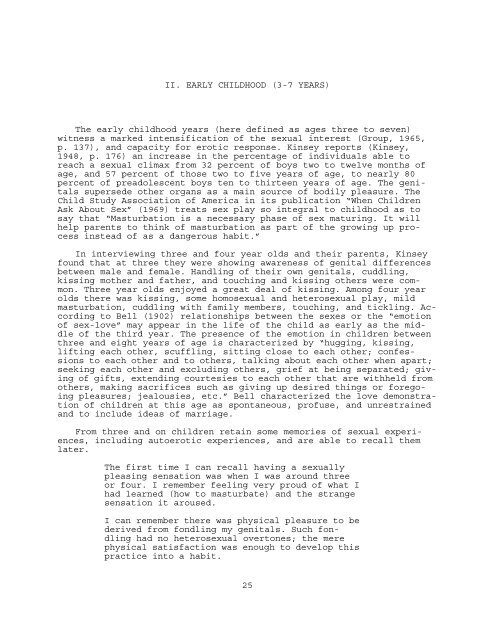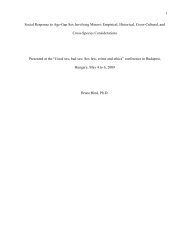Infant and Child Sexuality: A Sociological Perspective - Ipce
Infant and Child Sexuality: A Sociological Perspective - Ipce
Infant and Child Sexuality: A Sociological Perspective - Ipce
You also want an ePaper? Increase the reach of your titles
YUMPU automatically turns print PDFs into web optimized ePapers that Google loves.
II. EARLY CHILDHOOD (3-7 YEARS)<br />
The early childhood years (here defined as ages three to seven)<br />
witness a marked intensification of the sexual interest (Group, 1965,<br />
p. 137), <strong>and</strong> capacity for erotic response. Kinsey reports (Kinsey,<br />
1948, p. 176) an increase in the percentage of individuals able to<br />
reach a sexual climax from 32 percent of boys two to twelve months of<br />
age, <strong>and</strong> 57 percent of those two to five years of age, to nearly 80<br />
percent of preadolescent boys ten to thirteen years of age. The genitals<br />
supersede other organs as a main source of bodily pleasure. The<br />
<strong>Child</strong> Study Association of America in its publication “When <strong>Child</strong>ren<br />
Ask About Sex” (1969) treats sex play so integral to childhood as to<br />
say that “Masturbation is a necessary phase of sex maturing. It will<br />
help parents to think of masturbation as part of the growing up process<br />
instead of as a dangerous habit.”<br />
In interviewing three <strong>and</strong> four year olds <strong>and</strong> their parents, Kinsey<br />
found that at three they were showing awareness of genital differences<br />
between male <strong>and</strong> female. H<strong>and</strong>ling of their own genitals, cuddling,<br />
kissing mother <strong>and</strong> father, <strong>and</strong> touching <strong>and</strong> kissing others were common.<br />
Three year olds enjoyed a great deal of kissing. Among four year<br />
olds there was kissing, some homosexual <strong>and</strong> heterosexual play, mild<br />
masturbation, cuddling with family members, touching, <strong>and</strong> tickling. According<br />
to Bell (1902) relationships between the sexes or the “emotion<br />
of sex-love” may appear in the life of the child as early as the middle<br />
of the third year. The presence of the emotion in children between<br />
three <strong>and</strong> eight years of age is characterized by “hugging, kissing,<br />
lifting each other, scuffling, sitting close to each other; confessions<br />
to each other <strong>and</strong> to others, talking about each other when apart;<br />
seeking each other <strong>and</strong> excluding others, grief at being separated; giving<br />
of gifts, extending courtesies to each other that are withheld from<br />
others, making sacrifices such as giving up desired things or foregoing<br />
pleasures; jealousies, etc.” Bell characterized the love demonstration<br />
of children at this age as spontaneous, profuse, <strong>and</strong> unrestrained<br />
<strong>and</strong> to include ideas of marriage.<br />
From three <strong>and</strong> on children retain some memories of sexual experiences,<br />
including autoerotic experiences, <strong>and</strong> are able to recall them<br />
later.<br />
The first time I can recall having a sexually<br />
pleasing sensation was when I was around three<br />
or four. I remember feeling very proud of what I<br />
had learned (how to masturbate) <strong>and</strong> the strange<br />
sensation it aroused.<br />
I can remember there was physical pleasure to be<br />
derived from fondling my genitals. Such fondling<br />
had no heterosexual overtones; the mere<br />
physical satisfaction was enough to develop this<br />
practice into a habit.<br />
25
















